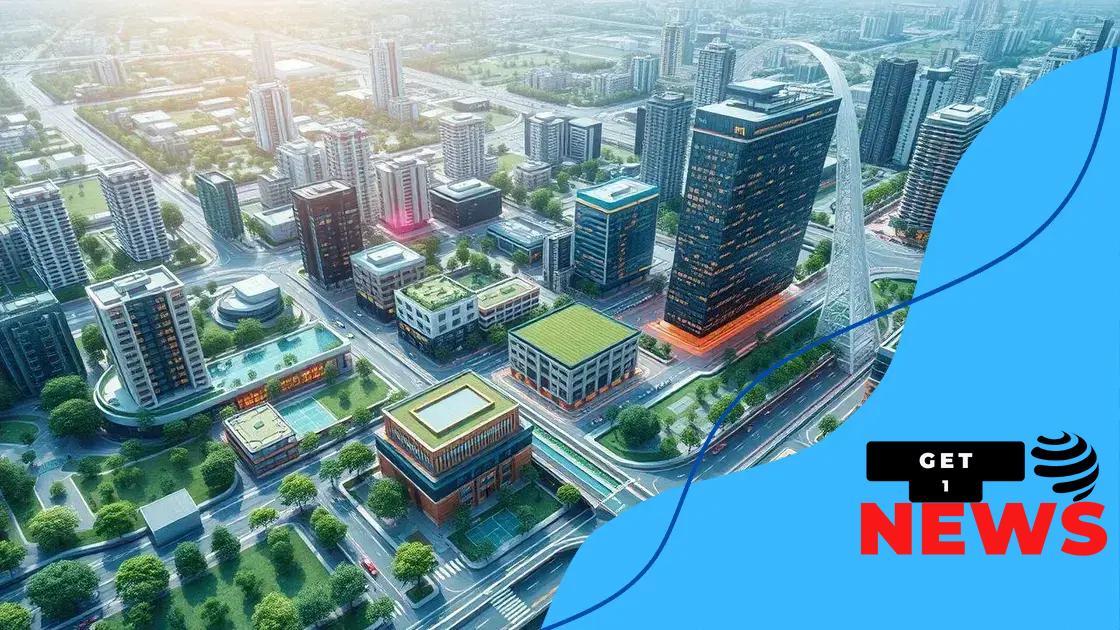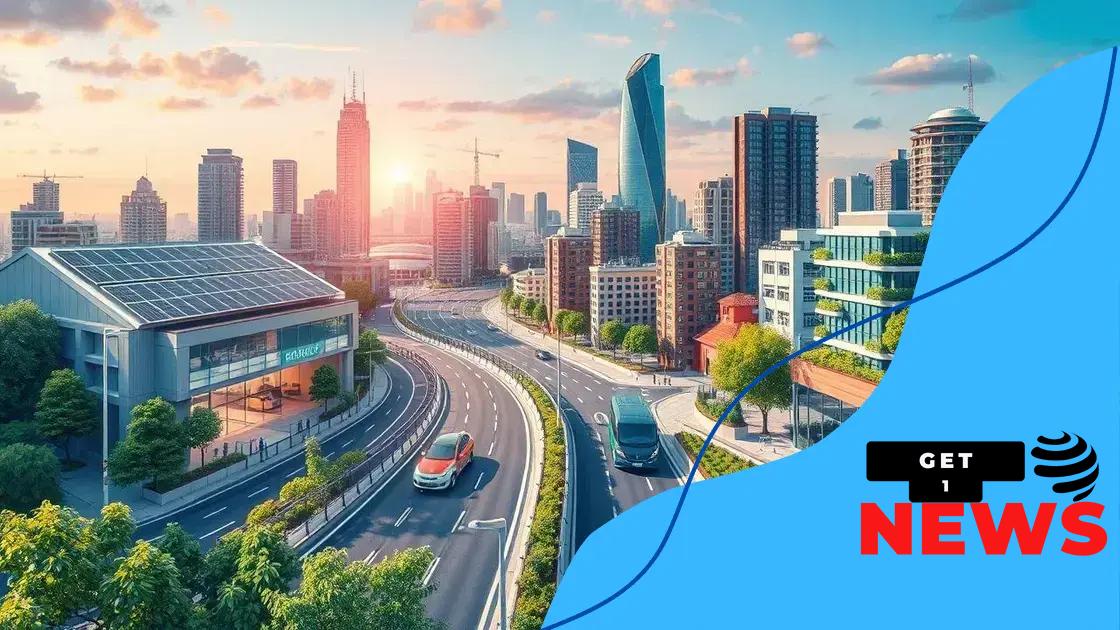Smart cities and sustainable urban development: a brighter future

Smart cities integrate technology and data to enhance urban living, focusing on sustainability, connectivity, and citizen engagement to improve quality of life and address urban challenges.
Smart cities and sustainable urban development are transforming the way we experience urban life. Have you ever wondered how technology can enhance your daily routines and improve living conditions? This article delves into the innovations shaping our cities.
Understanding smart cities and their core principles
Understanding smart cities is key to appreciating how technology can revolutionize urban living. These cities leverage advanced technologies to improve the quality of life for their residents. A smart city uses data and connectivity to enhance various aspects of urban life, including transportation, public safety, and environmental sustainability.
Core principles of smart cities
The foundation of a smart city is built on several core principles. Firstly, collaboration among various stakeholders, including residents, government, and businesses, is essential for developing effective solutions. Secondly, data-driven decision-making helps cities respond to the needs of their communities in real-time. Efforts are made to ensure that technology serves all citizens equitably.
- Connectivity: Reliable internet and communication technologies link people, services, and systems.
- Sustainability: Promoting environmentally friendly practices is crucial for long-term viability.
- Efficiency: Utilizing resources wisely leads to better urban management.
- Inclusivity: Ensuring that all citizens have access to digital services is vital for fair development.
Another important aspect is the use of intelligent infrastructure, which includes smart grids and energy-efficient buildings. These innovations not only improve functionality but also reduce the environmental impact of cities. Furthermore, smart cities constantly evolve by integrating new technologies, adapting to changes in society, and addressing emerging challenges.
Public safety is significantly enhanced through the use of smart surveillance systems and data analytics. By monitoring crime patterns, cities can allocate resources effectively, ensuring that law enforcement can respond quickly to incidents. Additionally, intelligent transportation systems reduce congestion and improve the overall flow of traffic.
Technologies driving sustainable urban development
Technologies play a crucial role in driving sustainable urban development. By integrating innovative tools and systems, cities can enhance efficiency while reducing their environmental impact. Among the most impactful technologies are smart grids, renewable energy sources, and advanced data analytics.
Smart grids
Smart grids facilitate efficient electricity distribution by monitoring usage in real-time. This technology allows cities to manage energy demand more effectively, reducing waste. By integrating renewable energy sources, smart grids help cities transition to less harmful energy. Solar panels and wind turbines are examples of how urban areas can generate clean energy.
- Real-time monitoring: It optimizes energy use and reduces outages.
- Integration of renewables: These systems easily incorporate solar and wind energy.
- Improved efficiency: Smart grids can lower operational costs in cities.
- Lower emissions: Utilizing renewable energy helps in reducing greenhouse gas emissions.
In addition to smart grids, green building technology is vital for sustainable urban development. Many cities are adopting standards that promote energy efficiency, such as LEED certification. These buildings often use materials that are sustainable and have a smaller carbon footprint. By maximizing natural light and implementing advanced insulation methods, they reduce energy consumption.
Moreover, advancements in data analytics allow cities to monitor environmental impacts. By tracking data on air quality, energy consumption, and waste management, urban planners can make informed decisions that promote sustainability. For example, traffic data can guide infrastructure development by highlighting areas in need of improvement.
Lastly, smart transportation systems greatly contribute by reducing congestion and pollution. These systems rely on real-time data to optimize public transit routes and manage traffic flow. With bike-sharing programs and electric vehicle charging stations, cities are making it easier for citizens to choose greener transportation options.
Case studies of successful smart cities

Examining case studies of successful smart cities provides valuable insights into how technology and innovation can reshape urban living. These examples showcase different approaches to becoming smarter and more sustainable, illustrating the benefits and challenges that cities face.
Barcelona
Barcelona serves as a leading example of a smart city, implementing various smart technologies to enhance urban life. The city has integrated a smart lighting system that adjusts based on the amount of natural light. This not only saves energy but also reduces costs.
- Wi-Fi networks: Free Wi-Fi in public areas improves connectivity for residents and tourists.
- Public transportation: Smart apps provide real-time updates, making commuting more efficient.
- Waste management: Sensors in waste bins alert services when they are full, optimizing collection routes.
These efforts have improved the city’s environmental sustainability while enhancing the quality of life for its citizens.
Singapore
Another standout is Singapore, which has embraced technology to establish a comprehensive smart city initiative. Known for its intelligent transport systems, Singapore uses data analytics to manage congestion and improve traffic flow.
- Smart traffic lights: Signal timings adjust based on real-time traffic conditions.
- Public services: Mobile apps deliver city services seamlessly to residents.
- Green initiatives: The city promotes urban greenery to combat climate change and enhance biodiversity.
These strategies have not only made travel easier but have also made Singapore a model for eco-friendly urban planning.
Moreover, cities like Amsterdam have implemented sustainable energy solutions, including wind and solar energy, to power smart infrastructure. Their use of electric vehicles and bike-sharing programs encourages environmentally-friendly practices among residents.
These case studies highlight the variety of challenges and solutions found in smart city development. From energy efficiency to improved public services, these cities illustrate that a commitment to technology and sustainability can create thriving urban environments.
Challenges in implementing smart city initiatives
Implementing smart city initiatives can lead to many benefits, but numerous challenges often arise throughout the process. City leaders need to navigate these hurdles while striving to create sustainable and efficient urban environments.
High Costs
One of the main challenges is the significant investment required for smart technology. Upfront costs for infrastructure upgrades, sensor installations, and maintenance can strain city budgets. However, the long-term savings on energy and resources can offset these initial expenses.
- Budget constraints: Many cities face financial limitations that hinder implementation.
- Funding sources: Identifying reliable funding sources can be a complex process.
- Return on investment: Demonstrating clear ROI can be difficult in the early stages.
Furthermore, integrating new technologies with existing systems poses technical challenges. Older infrastructure may not support the advanced systems needed for smart city initiatives, requiring extensive upgrades.
Data Security and Privacy
With the rise of smart technologies comes the increased risk of data breaches and privacy concerns. Collecting massive amounts of data can lead to questions about how that information is stored and protected.
- Data management: Ensuring that data is securely managed is crucial for maintaining trust.
- Compliance: Cities must navigate data protection regulations to avoid legal issues.
- Public trust: Building public confidence in smart initiatives is essential for community support.
Another challenge is addressing the digital divide. Not all residents have equal access to technology or the internet, which can lead to disparities in who benefits from smart city solutions. It’s essential to involve all community members in planning to ensure inclusivity.
Lastly, engaging citizens in the development of smart city projects can be difficult. Active participation is vital for success, but citizens may feel disconnected or unsure of how they can contribute.
The future of smart cities and their impact on society
The future of smart cities is filled with potential that could dramatically impact society. As urban areas continue to grow, the integration of technology will play a crucial role in enhancing the quality of life for residents.
Enhanced Connectivity
One major aspect of future smart cities is the emphasis on enhanced connectivity. With the rollout of 5G and improved internet infrastructure, residents will experience faster speeds and more reliable connections. This advancement will significantly benefit various sectors, from healthcare to education.
- Telehealth services: Easily accessible healthcare options will become more prevalent.
- Online education: Students will have greater access to resources and learning experiences.
- Remote work: Enhanced connectivity will support more people working from home.
Moreover, smart cities will utilize internet of things (IoT) devices to collect real-time data. This information will help local governments make informed decisions about infrastructure and services, improving urban management.
Sustainability Initiatives
Another essential aspect of the future is sustainability. With climate change becoming an increasingly pressing issue, smart cities will focus on green practices. This shift includes expanding renewable energy sources and implementing energy-efficient systems.
- Smart grids: Energy distribution will be optimized to reduce waste.
- Green buildings: New construction will focus on energy efficiency and sustainability.
- Waste management: Advanced technologies will enhance recycling and reduce landfill use.
With these efforts, urban areas can reduce their carbon footprints while promoting healthier living environments.
Furthermore, the future of smart cities will include greater citizen engagement. Residents will have more opportunities to participate in decision-making processes through digital platforms. This involvement will create a sense of community and ensure that urban development meets the needs of all citizens.
In summary, smart cities are set to transform urban landscapes into more connected, sustainable, and inclusive environments. The impact on society will be profound, driving innovation while addressing pressing urban challenges.
In conclusion, the future of smart cities holds great promise for enhancing urban living. By focusing on connectivity, sustainability, and citizen engagement, cities can become more efficient and inclusive. As we embrace new technologies, we can tackle challenges like climate change and urban congestion effectively. Smart cities not only improve the quality of life for residents but also foster community participation in decision-making. Together, we can shape a brighter and more sustainable urban future.
\n\n
\n
FAQ – Frequently Asked Questions about Smart Cities
What are smart cities?
Smart cities use technology and data to improve urban living, making cities more efficient, sustainable, and connected.
How can smart cities enhance sustainability?
By implementing renewable energy sources and efficient waste management, smart cities can significantly reduce their carbon footprint.
What role do citizens play in smart cities?
Citizens can engage in the planning and decision-making processes, ensuring that urban development meets their needs.
What challenges do smart cities face?
Challenges include high costs, data privacy concerns, technological integration, and ensuring equal access to technology for all residents.





